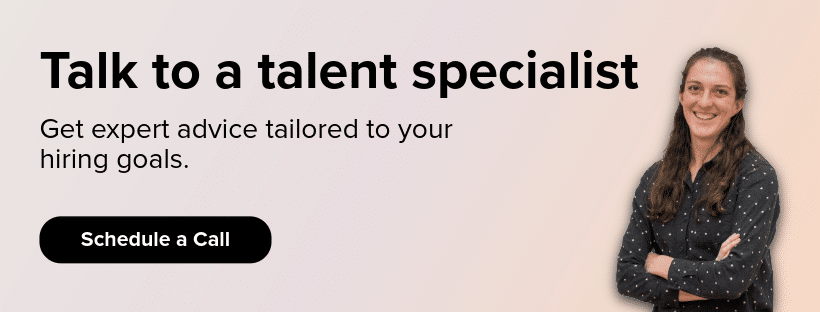
Great hiring isn’t just about filling a role—it’s about building a relationship that starts with the very first interaction. If your process feels automated or impersonal, it can have a significant impact on your employer brand and interest from top talent. The good news: shifting from transactional to personal doesn’t require bigger budgets; it requires intentionality, clarity, and a few new habits.
Key Takeaways:
- What Does a Personal Hiring Process Look Like?
- The Business Case for Prioritizing Candidate Experience
- Four Simple Improvements to Make Today
- How to Personalize at Scale
- Rethinking Interviews with Candidates in Mind
- The Hiring Manager’s Role in Candidate Experience
What Does a “Transactional” Hiring Process Look Like?
Transactional candidate experience treats people like entries in an ATS. It’s efficient, but forgettable—and often costly in brand equity. This might look like:
- Long silences after application or interviews.
- Generic updates that don’t say what’s next or when.
- Interview loops that feel unorganized, repetitive, or like an interrogation rather than a conversation.
- Offers that arrive without context, rationale, or a human touch.
- Feedback that never arrives—or arrives weeks too late.
The impact of a transactional process affects your candidates, leaving them with a less-than-ideal experience, but it’s also about your brand. Long-term, a transactional process communicates who you are as a company to candidates, but those candidates can turn into colleagues, customers, and suppliers. How you treat them matters.
What Does a “Personal” Hiring Process Look Like?
Personal doesn’t have to mean that every interaction has to be custom for each candidate, but it does mean the experience signals respect, clarity, and care. Key aspects include:
- Clear expectations: What to prepare, who they’ll meet, and how decisions get made.
- Tight communication: Predictable cadences and honest updates—especially when the update is “no update yet.”
- Interviewer readiness: People show up prepared, on time, and with the candidate’s resume read.
- Context-rich offers: Value exchange, growth path, team vision, and early goals.
- Constructive feedback: Specific, actionable, delivered promptly when feasible.
At its core, personal experience is about three things: speed, clarity, and respect.
The Business Case for Candidate Experience
The impact of a strong candidate experience is not a short-term one; you will see impact for years to come. By building relationships instead of candidate transactions, you are networking with future employees, community members, and potential customers. A more personal experience boosts offer acceptance, referrals, and team engagement. It also lowers early attrition through better expectation setting. This isn’t just about being nice; it’s a strategic lever.
Four Simple Improvements to Make Today
You don’t need a full overhaul to move the needle. Here are four changes you can start making today to move your process in the right direction.
- Set communication expectations: Commit to a 48-hour response after interviews and a weekly update for active candidates.
- Send interview prep guides to candidates: Share who they’ll meet, the competencies assessed, timing, and tips to prepare.
- Provide brief feedback: When you reject after interviews, share strengths and growth areas you observed. Keep it candid but kind; it’s better than silence.
Strategic Steps to Elevate Candidate Experience
How to Personalize at Scale
By using templates and key steps in your process to provide a personalized touch, you can provide a personal experience while still maintaining efficiency when you’re working with large volumes.
- Application acknowledgment: Use a warm, human template that explains timelines, stages, and a real contact point for questions.
- Hiring stage changes: Automate updates, but attach a short note referencing one detail from their resume or conversation.
- Interview scheduling: Ensure automation or individual scheduling is informed on the candidate’s time zone, current availability, and interview plan, helping the candidate feel like their time is valuable.
- Offer: Simply do it face-to-face. This is a non-negotiable here at DISHER. When it can be in person, make it happen; otherwise, be face-to-face over video. It allows you one last touch point for you to share why you’re extending and offer, and gives the candidate an opportunity to ask questions.
As we integrate AI and automation into our workflow, this is a key differentiator that it can make in your process. Let automation handle the monotonous tasks that don’t make an impact and free you up to provide the human touch where it counts. While other companies may automate too much, be the one still connecting and providing that human element.
Rethinking Interviews: From Gatekeeping to Value Exchange
Interviewing is a two-way assessment, not a stress test. Think about what value you are providing for the candidate, just as much as you consider what you need to learn to make a great hire.
- Prepare interviewers: Revisit the job description and non-negotiables for the role. Ensure the resume has been reviewed and key relevant candidate information has been shared.
- Cut redundancy: Assign competencies or topic areas for each interviewer to strategically evaluate and provide information. No more asking “Walk me through your resume” four times.
- Sell thoughtfully: Be transparent and share real areas where your company shines without over-promising. Guide candidates through career and growth path options and show them a strategic vision for where the team and company are going.
Use Candidate Feedback to Implement Impactful Change
To continuously improve your candidate experience, ask for candidate input at key touch points in your process, such as post-onsite, after the offer decision, and 30 days after start. Keep surveys brief. Use a net promoter score to gauge overall experience, one or two stage-specific questions, and a single open-ended prompt. Offer anonymity and trigger surveys automatically in your process.
Assign an owner for your candidate experience that will review candidate feedback monthly to spot themes and bottlenecks. Visible, fast action turns feedback from a survey into a habit—and moves hiring from transactional to genuinely personal.
The Hiring Manager’s Role
A hiring manager can make or break the candidate experience. Here are a couple of ways to provide the best experience:
- Be responsive: Accept or decline interviews within 24 hours. Share honest feedback and deal-breakers early.
- Prepare and be present: Read the resume, personalize your questions, and avoid multitasking.
- Communicate the why: Describe what impact the role will have in the company and set expectations for the first 90 days.
Build a Culture of Respect
Processes start the change; culture sustains it. Make commitments clear, measurable, and keep them in front of you so you stay accountable. Equip the team with quarterly training on interviewing and share candidate feedback to make continuous improvements as a team. Look at lessons learned after each hiring search honestly: what surprised us, where we can improve, and what candidates tell us? And always close the loop, so even a no feels informed and respectful.
Candidates remember how you made them feel. A personal experience isn’t fluff; it’s a strategic lever that compounds. Every prompt reply, every clear expectation, and every thoughtful interaction increases trust—and trust wins top talent. Start small, be consistent, and let your process reflect the culture you’re proud of. For hands-on help designing communications, interviews, and feedback loops that earn trust, connect with our talent consultants. Build a candidate experience that you are proud of.





